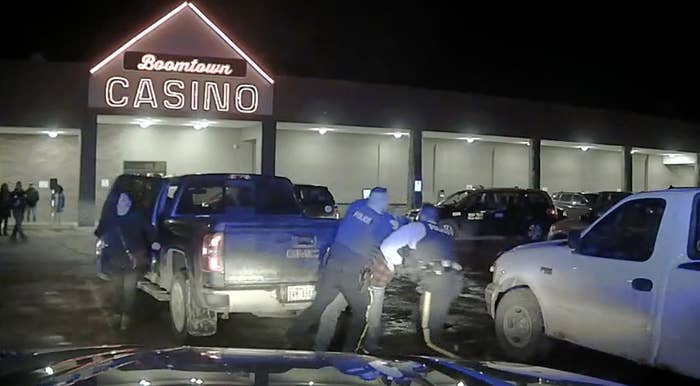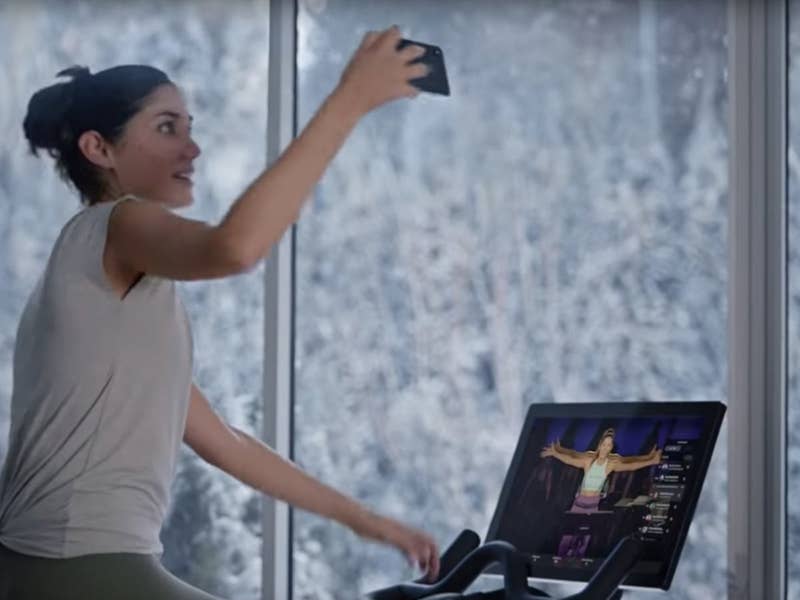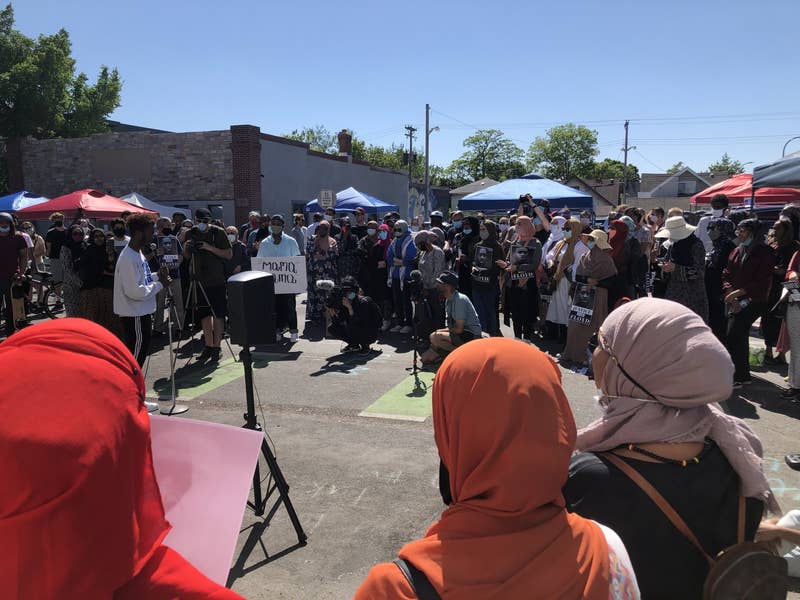By REGINA GARCIA CANO and MICHAEL CASEY

1 of 3
FILE - In this May 20, 2020, file photo, signs that read "No Job No Rent" hang from the windows of an apartment building during the coronavirus pandemic in Northwest Washington. The pandemic has shut housing courts and prompted authorities around the U.S. to initiate policies protecting renters from eviction. But not everyone is covered, and some landlords are turning to threats and harassment to force tenants out. (AP Photo/Andrew Harnik, File)
BALTIMORE (AP) — Jeremy Rooks works the evening shift at a Georgia fast-food restaurant these days to avoid being on the street past dusk. He needs somewhere to go at night: He and his wife are homeless after the extended-stay motel where they had lived since Thanksgiving evicted them in April when they couldn’t pay their rent.
They should have been protected because the state’s Supreme Court has effectively halted evictions due to the coronavirus pandemic. But Rooks said the owner still sent a man posing as a sheriff’s deputy, armed with a gun, to throw the couple out a few days after rent was due.
The pandemic has shut housing courts and prompted most states and federal authorities to initiate policies protecting renters from eviction. But not everyone is covered and a number of landlords -- some desperate to pay their mortgages themselves -- are turning to threats and harassment to force tenants out.
“Every day, they tried to basically get us out of there. It was basically like a game to them,” said Rooks, who wasn’t able to make his rent at the Marietta, Georgia, motel after his employer paid him late and his wife was laid off in the pandemic. “One of us had to stay in a room at all times because they wouldn’t redo the keys for us.”
The evictions threaten to exacerbate a problem that has plagued people of color like Rooks long before the pandemic, when landlords across the U.S. were filing about 300,000 eviction requests every month.
The data and analytics real estate firm Amherst projects that 28 million renters, or about 22.5% of all households, are at risk of eviction. Tenant advocates expect that number to increase significantly unless protections are put in place, and project that many of those affected will be African Americans and households led by women, both of which historically are more likely to be evicted.

FILE - In this May 21, 2020, file photo, people from a support organization for immigrant and working class communities unfold banners, including one advocating rent cancelation, on a subway platform in the Queens borough of New York during a vigil memorializing people who died from coronavirus. The pandemic has shut housing courts and prompted authorities around the U.S. to initiate policies protecting renters from eviction. But not everyone is covered, and some landlords are turning to threats and harassment to force tenants out. (AP Photo/Bebeto Matthews, File)
In a sign of what could happen nationally, Virginia has seen a crush of proceedings since eviction hearings resumed May 18. About 700 cases already have been heard statewide, according to Christie Marra, director of housing advocacy for the Virginia Poverty Law Center. On top of that, 2,200 cases are on the docket for the end of June and early July in Richmond, which has one of the country’s highest eviction rates.
Rachel Garland, an attorney at Community Legal Services in Philadelphia, said her group has experienced a spike in calls from tenants who lost their jobs due to the lockdown and fear being evicted. Philadelphia had the fourth-highest eviction rate in the country.
“Even if they can’t be evicted right now, if the courts are closed, the landlords are sending threatening emails, text messages, asking for rent, threatening to lock tenants out,” Garland said.
Alieza Durana of Princeton University’s Eviction Lab said affected tenants face high rates of depression and suicide from the stress, along with mounting debt and homelessness. Additionally, court judgments and debt collection actions against renters are reported to credit bureaus, affecting their ability to access housing for years.
Jose Ortiz, deputy director of Essex/Newark Legal Services, which includes New Jersey’s largest city, said he’s heard complaints from tenants who have been asked to exchange sex for rent and instances where landlords have threatened to alert immigration authorities about tenants living in the country without legal permission if they don’t pay their rent.
“They are not working. They don’t have the income to pay their bills and they are afraid about what will happen once the eviction ban is lifted,” Ortiz said. “Are they going to be displaced? Is there going to be a mad rush to the courthouse to get these tenants evicted?”
Tenants also are complaining about landlords locking them out and shutting off utilities.
Unable to pay her April rent in full on her townhouse in Millersville, Maryland, Dawn McBride said she began getting texts from her landlord suggesting she find work at Walmart or Costco. She said the landlord then tried to get her to sign a rent-deferral agreement, but wouldn’t let her fully read it. She ultimately was handed a 30-day notice to vacate because her lease was month-to-month, a strategy landlords increasingly are using.
“Honestly, it stresses me out a lot because it’s me and my children,” said McBride, who lost her pet-sitting job. “And, you know, I’m just like, `Where are we going to go?’”
Some tenants facing eviction have turned the table on landlords and are organizing rent strikes. From New York to Chicago to San Francisco, tenants are banding together and demanding landlords negotiate with an eye toward forgiving their rent entirely until the pandemic ends.
Many like Diana Hou, who lost her job with a political campaign and has helped organized a rent strike in her Brooklyn building with her half-dozen roommates. are pushing for legislation at the state and federal level to provide rent and mortgage relief.
“Many of us are worried about our prospects of securing housing without income and with a looming debt of unpaid rent. For the majority of the house, not being able to secure housing would mean homelessness in the middle of a pandemic,” Hou said.
Rachel Garland, an attorney at Community Legal Services in Philadelphia, said her group has experienced a spike in calls from tenants who lost their jobs due to the lockdown and fear being evicted. Philadelphia had the fourth-highest eviction rate in the country.
“Even if they can’t be evicted right now, if the courts are closed, the landlords are sending threatening emails, text messages, asking for rent, threatening to lock tenants out,” Garland said.
Alieza Durana of Princeton University’s Eviction Lab said affected tenants face high rates of depression and suicide from the stress, along with mounting debt and homelessness. Additionally, court judgments and debt collection actions against renters are reported to credit bureaus, affecting their ability to access housing for years.
Jose Ortiz, deputy director of Essex/Newark Legal Services, which includes New Jersey’s largest city, said he’s heard complaints from tenants who have been asked to exchange sex for rent and instances where landlords have threatened to alert immigration authorities about tenants living in the country without legal permission if they don’t pay their rent.
“They are not working. They don’t have the income to pay their bills and they are afraid about what will happen once the eviction ban is lifted,” Ortiz said. “Are they going to be displaced? Is there going to be a mad rush to the courthouse to get these tenants evicted?”
Tenants also are complaining about landlords locking them out and shutting off utilities.
Unable to pay her April rent in full on her townhouse in Millersville, Maryland, Dawn McBride said she began getting texts from her landlord suggesting she find work at Walmart or Costco. She said the landlord then tried to get her to sign a rent-deferral agreement, but wouldn’t let her fully read it. She ultimately was handed a 30-day notice to vacate because her lease was month-to-month, a strategy landlords increasingly are using.
“Honestly, it stresses me out a lot because it’s me and my children,” said McBride, who lost her pet-sitting job. “And, you know, I’m just like, `Where are we going to go?’”
Some tenants facing eviction have turned the table on landlords and are organizing rent strikes. From New York to Chicago to San Francisco, tenants are banding together and demanding landlords negotiate with an eye toward forgiving their rent entirely until the pandemic ends.
Many like Diana Hou, who lost her job with a political campaign and has helped organized a rent strike in her Brooklyn building with her half-dozen roommates. are pushing for legislation at the state and federal level to provide rent and mortgage relief.
“Many of us are worried about our prospects of securing housing without income and with a looming debt of unpaid rent. For the majority of the house, not being able to secure housing would mean homelessness in the middle of a pandemic,” Hou said.

FILE - In this May 30, 2020, file photo, a car caravan calling for the cancellation of rents during the coronavirus pandemic prepares to parade through Boston. The pandemic has shut housing courts and prompted authorities around the U.S. to initiate policies protecting renters from eviction. But not everyone is covered, and some landlords are turning to threats and harassment to force tenants out. (AP Photo/Michael Dwyer, File)
Jay Martin, executive director of the Community Housing Improvement Program, which represents 4,000 building owners in New York, said he doesn’t condone rent strikes but sympathizes with tenants’ plight.
“Renters need a bailout,” Martin said, adding that landlords are supporting federal proposals that would cover back rent and future payments. Without those measures, he predicted a drop in property and real estate taxes that would sap state and city budgets.
The federal government’s $2.2 trillion coronavirus rescue package includes eviction moratoriums for most people living in federally subsidized apartments, as well as homes covered by federally backed mortgages. A second $3 trillion coronavirus relief bill passed in May by the U.S. House would provide about $175 billion to pay rents and mortgages, but has almost no chance of passing in the Republican-controlled U.S. Senate.
State and local lawmakers across the country also are stepping in with assistance and proposals aimed at averting a wave of evictions.
New Jersey lawmakers passed a $100 million rent relief bill, while in Pennsylvania, Gov. Tom Wolf signed legislation directing $175 million of the federal coronavirus rescue package to rent and mortgage relief. Boston is providing $8 million for rental assistance, Baltimore has designated $13 million in federal coronavirus relief funding to start a rental assistance program, and Philadelphia provided $10 million to help about 13,000 people with their rent.
Other proposals would offer long-term payment plans for those unable to afford rent and programs like mediation before cases head to housing court.
“We have to do something,” said Philadelphia Council member Helen Gym, whose bill would prevent evictions until two months after the state’s emergency order was lifted.
“We can’t go back to business as usual in a city that evicts 18,000 people a year,” she said. “That is just not sustainable.”
Jay Martin, executive director of the Community Housing Improvement Program, which represents 4,000 building owners in New York, said he doesn’t condone rent strikes but sympathizes with tenants’ plight.
“Renters need a bailout,” Martin said, adding that landlords are supporting federal proposals that would cover back rent and future payments. Without those measures, he predicted a drop in property and real estate taxes that would sap state and city budgets.
The federal government’s $2.2 trillion coronavirus rescue package includes eviction moratoriums for most people living in federally subsidized apartments, as well as homes covered by federally backed mortgages. A second $3 trillion coronavirus relief bill passed in May by the U.S. House would provide about $175 billion to pay rents and mortgages, but has almost no chance of passing in the Republican-controlled U.S. Senate.
State and local lawmakers across the country also are stepping in with assistance and proposals aimed at averting a wave of evictions.
New Jersey lawmakers passed a $100 million rent relief bill, while in Pennsylvania, Gov. Tom Wolf signed legislation directing $175 million of the federal coronavirus rescue package to rent and mortgage relief. Boston is providing $8 million for rental assistance, Baltimore has designated $13 million in federal coronavirus relief funding to start a rental assistance program, and Philadelphia provided $10 million to help about 13,000 people with their rent.
Other proposals would offer long-term payment plans for those unable to afford rent and programs like mediation before cases head to housing court.
“We have to do something,” said Philadelphia Council member Helen Gym, whose bill would prevent evictions until two months after the state’s emergency order was lifted.
“We can’t go back to business as usual in a city that evicts 18,000 people a year,” she said. “That is just not sustainable.”




















